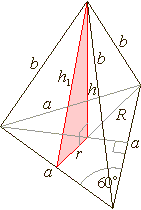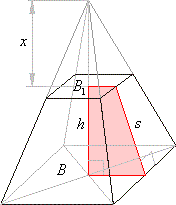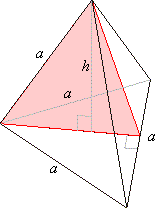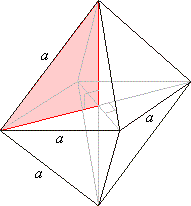|
| Solid
Geometry, Pyramids
and Regular Polyhedrons |
|
|
|
|
Pyramids |
 Regular
square pyramid
Regular
square pyramid
|
 Regular triangular pyramid
Regular triangular pyramid
|
 Regular hexagonal pyramid
Regular hexagonal pyramid
|
 Right
pyramidal frustum
Right
pyramidal frustum |
|
|
|
|
|
|
| Pyramid |
| A
solid whose base is a polygon and whose lateral faces are
triangles with a common vertex (apex) is called a pyramid. |
| A
right pyramid is a pyramid in which the line joining
the centroid of the base (the point of coincidence of the medians) and the apex is perpendicular to the base. |
| A
regular pyramid is a right pyramid whose base is a regular polygon and
lateral faces are congruent isosceles triangles. |
| The volume of a pyramid is one third of the product of the area of the base and the perpendicular distance from the vertex to the base. |
|
| The surface
area of a pyramid: |
S
= B
+ Slat |
|
| The volume of a pyramid: |
V
= 1/3 ·
B ·
h,
|
|
|
| where
B is
the base area, Slat
is the lateral surface area and h
is the height of the
pyramid. |
|
| Regular
square pyramid
|
| A
regular square pyramid has square base and lateral faces are
four congruent isosceles triangles making the same angle with
the base. |
|
|
|
|
| Regular triangular pyramid
|
| A
regular triangular pyramid has an equilateral triangle base, and
three congruent isosceles triangles as lateral faces making the same angle with
the base. |
|
 |
 |
|
| R
-the
radius of the circumcircle, r
-the radius of the incircle |
 |
-
surface |
 |
-
volume |
|
|
|
| Regular hexagonal pyramid
|
| A
regular hexagonal pyramid has a regular hexagon base, and six congruent isosceles triangles as lateral faces making the same angle with
the base. |
|
|
|
| Right
pyramidal frustum |
 |
| B
: B1 = (h + x)2
: x2 |
 |
 |
-
surface |
| P,
P1 - bottom
and top base perimeter |
|
 |
-
volume |
|
|
|
|
Regular Polyhedrons |
 Tetrahedron
Tetrahedron |
 Octahedron
Octahedron |
|
| Tetrahedron |
 |
|
|
|
|
|
| Octahedron |
 |
|
|
|
|
|
|
| The equilateral triangles are faces
of, the tetrahedron (4-faced), the
octahedron (8) and the icosahedron (20),
while the
dodecahedron
consists of 12 regular pentagons. |
|
|
|
|
|
|
|
|
|
|
|
| Beginning
Algebra Contents E |
|
|
 |
|
| Copyright
© 2004 - 2020, Nabla Ltd. All rights reserved. |